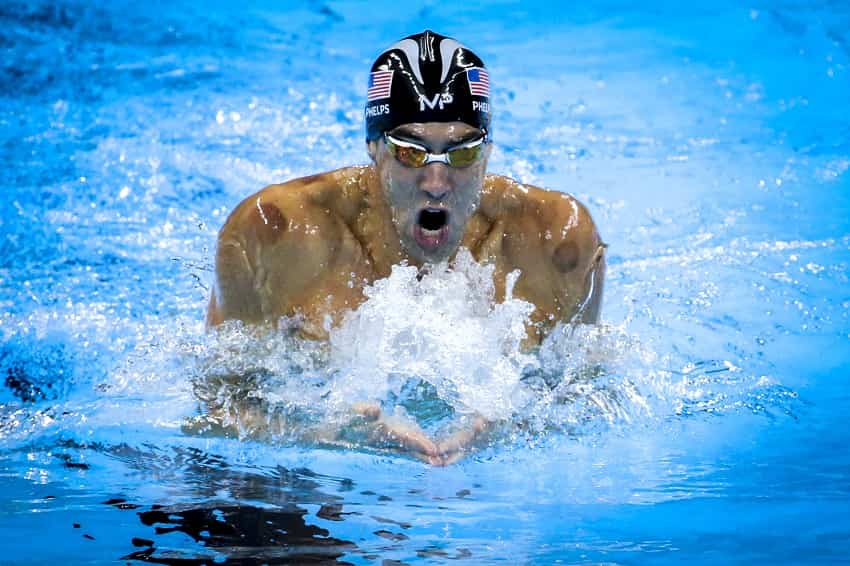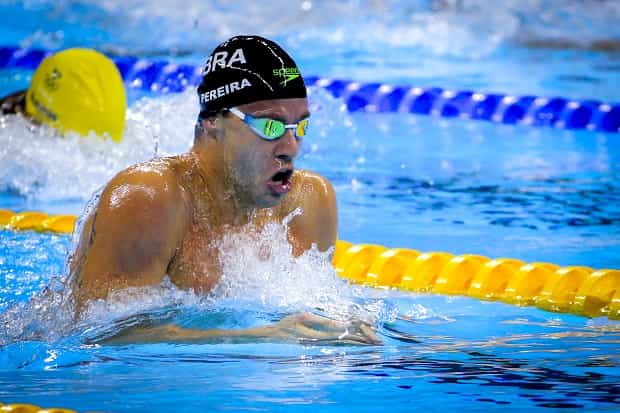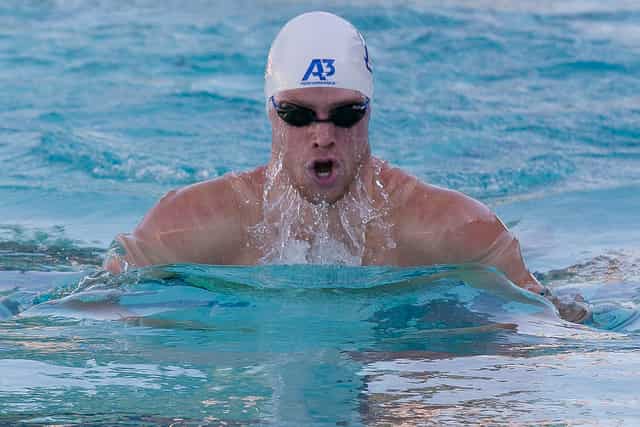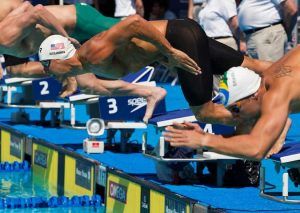Here is everything you ever wanted to know about the oldest stroke in competitive swimming, the breaststroke.
The breaststroke is one of the four swimming strokes performed in competitive swimming, and in the author’s opinion, the hardest to master.
Sure, the butterfly stroke is exhausting, but the breaststroke, despite its seemingly simple nature, requires a timing between the pulling and kicking motion is challenging to truly get the hang of.
Here is everything you need to know about the breaststroke, as well as a hefty list of resources for helping you swim a better breaststroke, from improving your kick, your pull, to a list of breaststroke drills that will help you improve your breast.
Let’s get our breaststroke on!
The History of the Breaststroke
The breaststroke is the grand-daddy of the swimming strokes, with its origins going back as far as the Stone Age.
Drawings in an Egyptian cave, appropriately called the Cave of Swimmers, depict swimmers in various poses, with the leg whipping motion believed to having been inspired by frogs. Similar illustrations were found in Babylonian and Assyrian wall drawings.

The first manual on swimming instruction was written by Nicolas Wynman, back in 1538. Back then swimming wasn’t so much about getting to the other end of the pool fast, but more about the whole not drowning and dying thing. In his book, Colymbetes, the German professor outlined instruction for a breaststrokish type stroke.
“Introducing the Finalists for the 440 Yard Breaststroke…”
The first time the breaststroke was raced at the Olympics was in 1904.
Those Games, based in St. Louis, were remarkable for the fact it was the first time the breaststroke was raced, but it was also the only Olympics that was held in yards.
That first breaststroke race was held over a distance of 440 yards.
By the 1930’s swimmers doing breaststroke found that it was possible to speed up their recovery by bringing their arms out of the water. This was the beginning of the fork of the road that would lead to two separate strokes, the breaststroke and the butterfly stroke.
The Underwater Shenanigans of ‘56
During the 1950’s, foreshadowing problems that would emerge for the backstroke and butterfly during the 1980’s and 1990’s, swimmers sneakily figured they could swim faster under the surface of the water.
Masaru Furukawa of Japan, at the 1956 Olympics in Melbourne stayed under the water off the start, and over the first 150m swam the first 45m of each length, on his way to winning the gold medal in the 200m breaststroke in 2:34.7.
Predictably, this new technique led to problems, with swimmers passing out from oxygen deprivation.
Two big rule changes emerged from this period:
- Swimmers could only do one underwater stroke (what has come to be known as the underwater breakout) off the start and turns.
- And swimmers had to have their head break the surface of the water during each stroke cycle.
Kitajima and the Dolphin Kicks Heard Around the World
The underwater dolphin kick is the little problem child of our sport, instigating rule changes across all strokes.
It was only a matter of time before it caused problems in the breaststroke, and this happened in 2004.
That summer at the Athens Olympics Kosuke Kitajima of Japan performed a single dolphin kick off of the start and turn, powering him to edge out Brendan Hansen in the final of the 100m breaststroke. Because the kicks were not visible from above the water the officials were unable to disqualify Kitajima, resulting in controversy.
Since then FINA has amended the rules to allow a single dolphin kick on the breakout. The swimmer can perform this kick at any point during the push off and pull-out.
Who are the top breaststrokers of all time?
- Victor Davis (CAN). The man, the myth, the temper! With several Olympics gold medals and world records to his credit, Victor Davis’ life was cut tragically short at the age of 25. His impact on Canadian swimming has lasted to this day, with a memorial fund that has helped support over 100 swimmers in their pursuit of their own Olympic dreams.
- Adam Peaty (GBR). Peaty utterly demolished the competition and the world record in the 100m breaststroke at the Rio Olympics. His swim was one of the highlights of the meet, and made him one of the top male swimmers in the world. On the final night in Rio he became the first man to ever swim a :56 split in the 100m breaststroke during the medley relay, powering GBR to a silver medal behind the USA.
- Mike Barrowman (USA). His world record in the 200m breaststroke stood for nearly 10 years. Barrowman took the “wave” technique of breaststroke and mastered it, shaving nearly 3 seconds off of the 200 WR mark in the span of 3 years. He won the Olympic gold in Barcelona in the distance.
- Kosuke Kitajima (JPN). A 4-time Olympian Kitajima swept the gold medals in the 100 and 200m breaststroke at the 2004 and 2008 Olympics. He would break the world marks in both distances, the final time in 2008 when he shaved a second off of Brendan Hansen’s (USA) record, swimming a 2:07.51.
- Rebecca Soni (USA). Another two-time Olympic champion, Soni dominated the field twice in the 200m events in Beijing and in London, both times in world record time. Soni closed off a successful international career with over twenty medals, including 14 silver.
- Penelope Heyns (RSA). Heyns became the first woman to sweep both breaststrokes in Olympic competition at the 1996 Olympic Games in Atlanta. More noteworthy, perhaps, is that she was also the first athlete from South Africa to win gold following the country’s reinstatement to the Olympic following apartheid. She closed off a long, consistent career with another bronze medal in the 100m breaststroke at the 2000 Sydney Games.
The Different Styles of Breaststroke
Through much of the 20th century it was thought that the fastest way to perform the stroke was to swim as flat as possible.
But during the 1970s the stroke began to evolve, with swimmers adopting a more undulating style that more closely resembles how today’s breaststrokers perform the stroke.
This new type of breaststroke, more commonly known as the “wave” breaststroke, was popularized by ISHOF-inductee Joszef Nagy, who coached Mike Barrowman (USA), Sergio Lopez-Miro (SPA), and Annamay Pierse (CAN) to world records and Olympic gold.
Adam Peaty of Great Britain has since revolutionized the way sprint breaststroke is performed. With a stroke rate that is out of this world Peaty powered his way to a 57.13 at the Rio Olympics. No one has swum within a second of this mark in history.
How to Swim Breaststroke
The breaststroke is the slowest of the four strokes. The reason for this is the large fluctuations in speed between sections of the stroke.
Although breaststrokers can generate great power and speed through the pulling motion, and even when kicking through the arm recovery, the leg recovery causes a near complete arrest in propulsion.
It’s like each time the legs recover the swimmer is throwing the hand-break on while trying to speed across the pool.
As a result, although it might look like an easy stroke, breaststroke requires great strength and stamina in order to get back up to speed with each stroke cycle.
Here are some tips for how to swim breaststroke from Sergio Lopez-Miro, Olympian and associate head coach at Auburn University:
1. The breaststroke pull.
There are two different ways to do the pulling motion:
- Turning-pressing out motion (your hands and arms form a Y at the beginning of the pull);
- A pressing down pulling motion.
The pressing down pull is more efficient for short course sprint events, while the turning-pressing out pull is best for longer short course breaststroke events (the 200, plus 200-400 IM) and long course swimming.
2. Breathing.
When breathing during the stroke cycle hold your breath until you are about to break the surface of the water, exhaling all at once right before you pick your head up. Holding your breath for those extra few moments will help give you more buoyancy in the water.
3. Shoulder position.
When breathing squeeze your shoulders and bring them up to your ears. To insure that you are throwing your body forward through the water imagine yourself rotating your shoulders over your ears.
4. The arm recovery.
Use your hands to aim for where you want to lunge your head. Your hips will follow your head, so aim to “jump forward”, bringing your hands just below the surface of the water.
5. The kicking motion.
The breaststroke kick is an unnatural movement, requiring athletes to have significant flexibility in their ankles and hips in order to turn the feet in a dorsi-flexed position at a 90-degree angle in order to create thrust.
- At the end of your kick your feet should be together.
- Speed your heels towards your butt.
- Knees should be approximately shoulder-width, and resist the urge to bring the knees up.
- Kick straight backwards and make sure that your feet are pointing backwards and not down.
6. Timing the pull and kick motions.
The kicking motion begins just after the swimmer has completed the pull. The kick accelerates and powers the lunge of the arms and the head into the next stroke cycle.
Breaststroke Resources
Over the past couple years we have put together a fair amount of awesome content for breaststrokers, including drills, workouts and sets from Olympians and head coaches from across the United States.
Here are our top resources for helping you swim better breaststroke:
How to Improve Your Breaststroke Kick. Two-time Olympian Mike Alexandrov shares a set of breaststroke kicking drills (including video demonstrations) that will help you improve your kicking technique.
How to Fix and Prevent Breaststroker’s Knee. Along with swimmer’s shoulder the breaststroker’s knee is a common injury among competitive swimmers, and also not just limited to breaststroker’s. Here is Michael Phelps’ long-time trainer and USA Swimming high performance manager Keenan Robinson to help you avoid and deal with this specific injury.
1-Arm, 1-Leg Breaststroke: A Drill to Develop Race Tempo Breaststroke. Quicksilver Swimming coach and former PAC-10 champion in the 100 breaststroke Andre Salles-Cunha drops an advanced breaststroke drill to help you set up race tempo.
How to Improve Your Breaststroke Pull. Here is a breaststroke drill progression that will help you improve your breaststroke pull from top to bottom.
How to Fix the Timing in Your Breaststroke. The timing in breaststroke is a toughie–fortunately we got Jeff Julian, head coach of Rose Bowl Aquatics, to stop by with his favorite drill for improving it.
Olympic Breaststroker Mike Alexandrov’s Favorite Breaststroke Set. More good stuff from Mike–here’s a set that covers all your bases, from power to endurance to speed.









